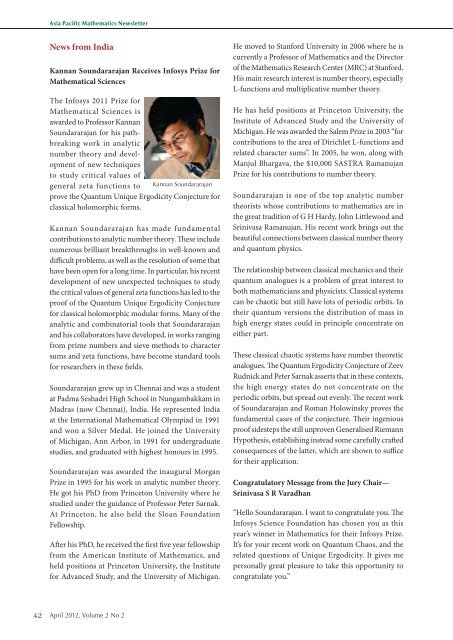Mathematics Newsletter
Mathematics Newsletter
Mathematics Newsletter
Create successful ePaper yourself
Turn your PDF publications into a flip-book with our unique Google optimized e-Paper software.
42<br />
Asia Pacific <strong>Mathematics</strong> <strong>Newsletter</strong><br />
News from India<br />
Kannan Soundararajan Receives Infosys Prize for<br />
Mathematical Sciences<br />
The Infosys 2011 Prize for<br />
Mathematical Sciences is<br />
awarded to Professor Kannan<br />
Soundararajan for his pathbreaking<br />
work in analytic<br />
number theory and development<br />
of new techniques<br />
to study critical values of<br />
general zeta functions to Kannan Soundararajan<br />
prove the Quantum Unique Ergodicity Conjecture for<br />
classical holomorphic forms.<br />
Kannan Soundararajan has made fundamental<br />
contributions to analytic number theory. These include<br />
numerous brilliant breakthroughs in well-known and<br />
difficult problems, as well as the resolution of some that<br />
have been open for a long time. In particular, his recent<br />
development of new unexpected techniques to study<br />
the critical values of general zeta functions has led to the<br />
proof of the Quantum Unique Ergodicity Conjecture<br />
for classical holomorphic modular forms. Many of the<br />
analytic and combinatorial tools that Soundararajan<br />
and his collaborators have developed, in works ranging<br />
from prime numbers and sieve methods to character<br />
sums and zeta functions, have become standard tools<br />
for researchers in these fields.<br />
Soundararajan grew up in Chennai and was a student<br />
at Padma Seshadri High School in Nungambakkam in<br />
Madras (now Chennai), India. He represented India<br />
at the International Mathematical Olympiad in 1991<br />
and won a Silver Medal. He joined the University<br />
of Michigan, Ann Arbor, in 1991 for undergraduate<br />
studies, and graduated with highest honours in 1995.<br />
Soundararajan was awarded the inaugural Morgan<br />
Prize in 1995 for his work in analytic number theory.<br />
He got his PhD from Princeton University where he<br />
studied under the guidance of Professor Peter Sarnak.<br />
At Princeton, he also held the Sloan Foundation<br />
Fellowship.<br />
After his PhD, he received the first five year fellowship<br />
from the American Institute of <strong>Mathematics</strong>, and<br />
held positions at Princeton University, the Institute<br />
for Advanced Study, and the University of Michigan.<br />
April 2012, Volume 2 No 2<br />
He moved to Stanford University in 2006 where he is<br />
currently a Professor of <strong>Mathematics</strong> and the Director<br />
of the <strong>Mathematics</strong> Research Center (MRC) at Stanford.<br />
His main research interest is number theory, especially<br />
L-functions and multiplicative number theory.<br />
He has held positions at Princeton University, the<br />
Institute of Advanced Study and the University of<br />
Michigan. He was awarded the Salem Prize in 2003 “for<br />
contributions to the area of Dirichlet L-functions and<br />
related character sums”. In 2005, he won, along with<br />
Manjul Bhargava, the $10,000 SASTRA Ramanujan<br />
Prize for his contributions to number theory.<br />
Soundararajan is one of the top analytic number<br />
theorists whose contributions to mathematics are in<br />
the great tradition of G H Hardy, John Littlewood and<br />
Srinivasa Ramanujan. His recent work brings out the<br />
beautiful connections between classical number theory<br />
and quantum physics.<br />
The relationship between classical mechanics and their<br />
quantum analogues is a problem of great interest to<br />
both mathematicians and physicists. Classical systems<br />
can be chaotic but still have lots of periodic orbits. In<br />
their quantum versions the distribution of mass in<br />
high energy states could in principle concentrate on<br />
either part.<br />
These classical chaotic systems have number theoretic<br />
analogues. The Quantum Ergodicity Conjecture of Zeev<br />
Rudnick and Peter Sarnak asserts that in these contexts,<br />
the high energy states do not concentrate on the<br />
periodic orbits, but spread out evenly. The recent work<br />
of Soundararajan and Roman Holowinsky proves the<br />
fundamental cases of the conjecture. Their ingenious<br />
proof sidesteps the still unproven Generalised Riemann<br />
Hypothesis, establishing instead some carefully crafted<br />
consequences of the latter, which are shown to suffice<br />
for their application.<br />
Congratulatory Message from the Jury Chair—<br />
Srinivasa S R Varadhan<br />
“Hello Soundararajan. I want to congratulate you. The<br />
Infosys Science Foundation has chosen you as this<br />
year’s winner in <strong>Mathematics</strong> for their Infosys Prize.<br />
It’s for your recent work on Quantum Chaos, and the<br />
related questions of Unique Ergodicity. It gives me<br />
personally great pleasure to take this opportunity to<br />
congratulate you.”


